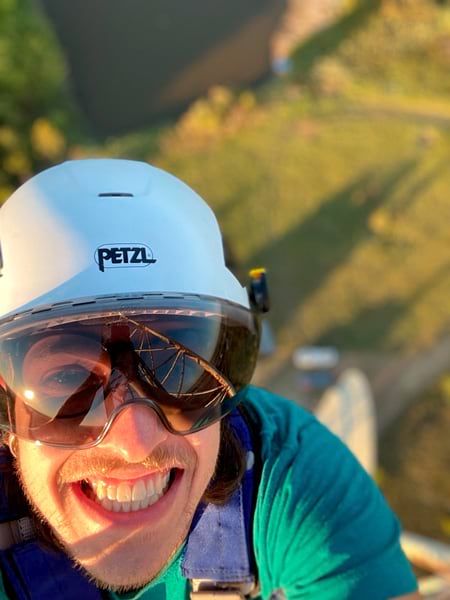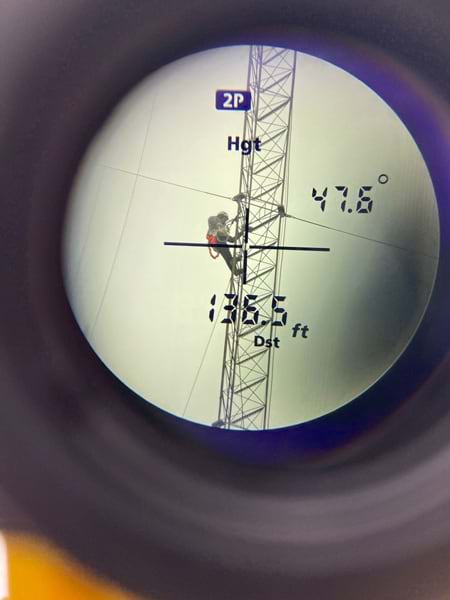Cell towers have a way of announcing themselves against the natural landscape. Whether surging upward in an open field or a stand of trees, they’re hard to miss on a clear day. At night, flashing beacons warn low-flying aircraft of their presence. The average cell phone tower stands between 50 and 200 feet (roughly 15 to 60 meters), with some soaring hundreds of feet higher. Maintaining them is a demanding job that requires not only attention to detail, but also the guts to harness up and climb these huge structures.
Matt Edrich knows this all too well. He’s the product manager for FieldSync, a data acquisition and analytics technology company, who climbs cell towers as part of his job. But while the wind-whipping experience of inspecting towers from bottom to top is a cherished part of the work, most of what Edrich does revolves around developing the next generation of geospatial tools and workflows for others to use while gathering streams of field data.

“At FieldSync, we’re doing a lot of maintenance and conditioning reporting on telecom assets, mapping out cell phone towers for engineering purposes, and then sourcing parts to maintain all that infrastructure,” Edrich said.
Given the size of cell tower sites plus the amount of information that needs gathering, traditional maintenance and conditioning reporting can easily take a team four to six hours of climbing, scribbling notes, and taking photos. That process, combined with sometimes hours of travel time between towers, can mean completing more than one site a day is often not in the cards.
With the help of geospatial technology used to collect and process this data—such as ArcGIS Survey123—that’s changing. But just as integral to Edrich’s process has been his involvement in Esri Community, which enables him to bounce ideas off other GIS professionals and develop more efficient workflows for cell tower maintenance.
Transforming Telecom Data
Edrich is constantly working to use GIS technology—including drones and devices that run ArcGIS Survey123 in the field—to change the way the company understands and maintains its structural assets. His goal has been to create a single workflow that starts with drone imagery, rather than data solely captured by climbers. This data is collected in ArcGIS Survey123 reports.
Streamlining this workflow has enabled Edrich to cut down on the time it takes to complete site reporting by about
75 percent.
“Using this process, I was able to complete a 500-foot-tall tower in 90 minutes, which is unheard of,” said Edrich. “That kind of efficiency gain is not at all [common] in the industry.”
The vastly reduced site-reporting time frame has allowed Edrich, along with other FieldSync staff, to use their time more efficiently and productively. Clients opting for climber-powered reporting over drone-enhanced services are still coming around to these kinds of efficiencies, as well as a degree of informed decision-making that was previously out of reach.
“You can have your data talk to itself and inform what your field technicians are doing and what they should do in the next five minutes because of what was done last month, which is not a thing in this little sector of telecom right now,” said Edrich. “We consistently hear from our customers that we’re changing what their expectations are for data on their towers, which is entirely possible because of ArcGIS Survey123. And the things you can do with ArcGIS Survey123, at least for us, were unlocked by Esri Community.”

Finding Support and Camaraderie in Community
During the years Edrich has been involved with Esri Community, he has relied on the group-powered resource for a variety of needs.
“Almost everything I do right now is in ArcGIS Survey123,” he said. “I’m looking in Esri Community to see if I’m doing things the best or the most controllable way.”
Edrich relishes discovering he’s not the only user trying to solve a particular challenge or track down a piece of information in Esri’s expansive product documentation. Often, another user has already located some needed information or solved a tricky issue and shared their findings in Esri Community, saving him significant time and effort.
“You kind of realize you’re at the edge of a sandbox,” Edrich noted. “We can refine what we have now and consider other Esri products that can support this capacity or find workarounds that are not in this particular ArcGIS Survey123 software.”
Edrich’s experience collaborating with other ArcGIS users on Esri Community has led him to advocate for new capabilities through the ArcGIS Ideas Exchange. It’s also led him to encourage others who might not be taking advantage of this resource to get involved.
“Just do it. As simple as that is to say, you learn the most by engaging with your peers and being honest about what you’ve tried and where your shortcomings are. I feel like a lot of people have this idea that they’re going to get roasted because they don’t know the answer to some question. That’s never been the case,” said Edrich. “It can help you expand your critical thinking process for how to solve problems.”


